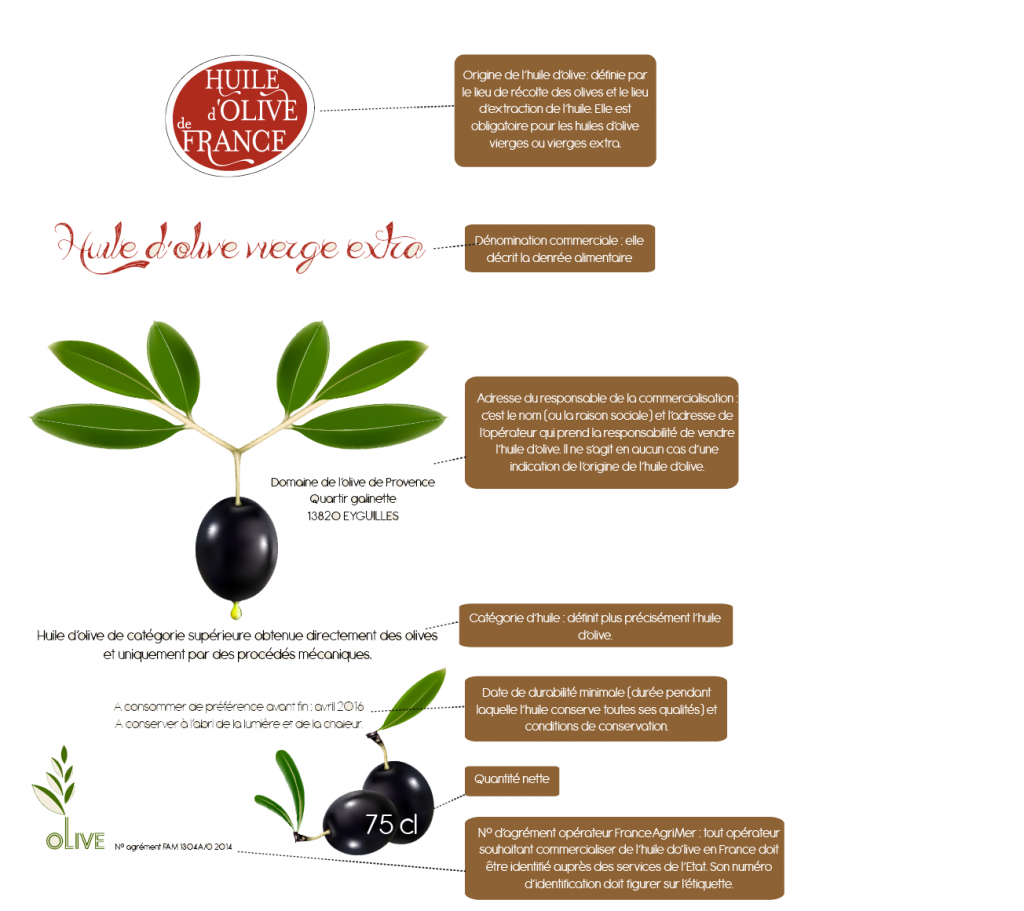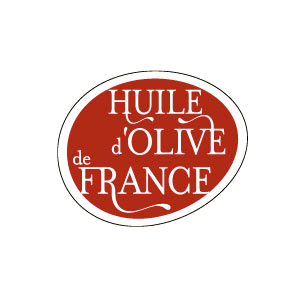Read a label (copy)
When it’s possible, ask for tasting the olive oil before buying it !
In summary
Mandatory information on labels
Origin
The European legislation imposes the mention of origin on the label for all virgin or extra virgin olive oils sold in the European Union.
The origin is clearly defined : both the harvesting location of olives and the extraction place of oil define the origin of olive oil.
On labels, different mentions may be stated :
- the mention « Origine » + the name of the UE country indicates that olive oil has been extracted in this country from olives harvested in this country.
- the mention «Huile d’olive de France» (or «Origine France», «Produit de France») guarantees a 100 % French olive oil: olives are harvested in France and oil is extracted in a mill on French soil.
- the mention «Appellation d’Origine Protégée – AOP (= PDO – Protected Designation of Origin) (or Appellation d’Origine Contrôlée – AOC) huile d’olive de …» and the logo guarantee an olive oil from a particular terroir combined to traditional know-how and varieties.
- the mention «Origine UE» indicates that olive oil comes from one or several countries of the European Union (Spain, Italy,…).
- the mention «Origine UE et non UE» indicates that olive oil comes from countries of the European Union and other countries (Tunisia…).
Good to know : the address mentioned on the label gives only an indication on the person responsible for the marketing. It is absolutely not an indication of origin.
The trade name
It’s the description of a product. For the oil coming from olives, there are : extra virgin olive oil, virgin olive oil, olive oil composed of refined olive oils and virgin olive oils, and olive-pomace oil. This classification is established by the European regulation which defines each trade name depending on precise physicochemical and organoleptic criteria (free acidity rate, peroxide index,…).
Extra virgin olive oil : no defect in mouth or nose, free acidity rate ≤ 0,8 %…
Virgin olive oil : light defect possible in mouth or nose, free acidity rate ≤ 2 %…
The olive oil category
For each trade name, categories are clearly defined. The consumer can understand better the trade name and then the product :
For extra virgin olive oil : “superior category olive oil obtained directly from olives and solely by mechanical means”
For virgin olive oil : “live oil obtained directly from olives and solely by mechanical means”
For olive oil composed of refined olive oils and virgin olive oils : “oil comprising exclusively olive oils that have undergone refining and oils obtained directly from olives”
For olive-pomace oil : “oil comprising exclusively oils obtained by treating the product obtained after the extraction of olive oils and oils obtained directly from olives – or oil comprising exclusively oils obtained by processing olive pomace and oils obtained directly from olives”.
What does « virgin » mean for vegetable oils ?
The mention of the word “virgin” in the name of the vegetable oils indicates that oil has been extracted by means that do not change the qualities of the product. If the trade name doesn’t have this mention, this means that the oil has been obtained by refining or by other processes removing the taste, the smell and the color.
The word “virgin” means that the olive oil is extracted by mechanical means preserving all the qualities of the product (the oil present in the fruit). So this is a pure fruit juice.
A refined olive oil is a lampante oil (which does not fit for consumption) which is processed (chemically and physically) to remove its color, smell and taste. Contrary to other vegetable oils such as sunflower or rapeseed oil, the regulation forbids its sale as it is, it has to be mixed with virgin olive oil. This is then sold with the name “olive oil composed of refined olive oil and virgin olive oil”.
Good to know : we only find this kind of olive oil in some ready-cooked dishes in France but it represents 50% of the Spanish consumption of olive oils.
The conditions of preservation
It is the duration during which the oil keeps all its gustative and physicochemical qualities. The olive oil, as for each foodstuff with a date of minimum durability (DMD), is not an ultra-perishable foodstuff.
The olive oil can be consumed without any danger for human health after the DMD but, could loose some of its gustative qualities.
The identification of the person responsible for marketing
Name or company name + address of the producer, of the conditioner or of the importer. It does not presume of the origin of olive oil except if the mention “producteur” – producer is stated (the mention induces that the oil comes from the olives of the olive grower).
The optional mentions
Mentions which can help you in your choice :
the organoleptic characterics : this is the aromatic description of olive oil (there are many different tastes for olive oils as for wines)
the variety : the mentions of the variety(-ies) used can give you an indication about the origin.
Learn more about the varieties and European Protected Designation of Origin (PDO) !
The mention “AB” or “issue de l’agriculture biologique” (from organic production) indicates a way of production of olives and an olive oil extraction in accordance to the organic production specifications. This mention does not indicate either a quality or a specific taste.
Mentions less important in the choice of an olive oil :
- Pression à froid / Extraite à froid (cold pressing / cold extraction) : these mentions indicate the system used (pressure / centrifugation or percolation) and an extraction temperature inferior to 27 °C. These mentions do not prejudge of olive oil quality.
- The acidity rate, the peroxide index (…)









